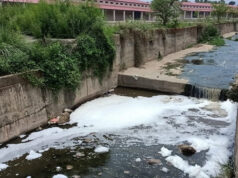The groundwater in Punjab and Haryana has been found to contain dangerously high levels of uranium, nitrates, arsenic, chloride, and fluoride, exceeding the permissible limits for safe consumption. This alarming revelation comes from the Annual Ground Water Quality Report-2024 released by the Central Ground Water Board (CGWB), which highlights a worsening water contamination crisis in the region.
According to the report, uranium levels in 20 districts of Punjab and 16 districts of Haryana exceed the safe limit of 30 parts per billion (ppb). The contamination has been attributed to excessive use of phosphate fertilisers, urbanisation, and local geological conditions. Studies have shown that phosphate fertilisers contain uranium concentrations ranging from 1 mg/kg to 68.5 mg/kg, which seep into the groundwater over time. The situation is particularly severe in overexploited groundwater zones, where reduced water levels hinder the natural dilution of contaminants.
Rising Nitrate Contamination
The report also found high nitrate concentrations in 128 groundwater samples from Haryana and 112 samples from Punjab, surpassing the safe limit of 45 mg per litre. Bathinda in Punjab is one of the most affected districts, with 46% of samples failing the test. The presence of nitrates in water is primarily linked to intensive agriculture, overuse of nitrogen-based fertilisers, and animal waste runoff. Consuming water with excessive nitrate levels can cause blue baby syndrome in infants and other severe health issues.
Also Read: From Green Revolution Glory to Groundwater Gloom: IIT Mandi Reveals Punjab’s Troubling Water Reality
Arsenic, Fluoride, and Chloride Levels Pose Further Risks
The report also revealed arsenic contamination in 12 districts of Punjab and 5 districts of Haryana, with concentrations exceeding 10 ppb. Long-term exposure to arsenic can lead to cancer, cardiovascular diseases, and diabetes. The contamination is mainly found in aquifers up to 100 metres deep, whereas deeper aquifers remain largely unaffected.
Excessive fluoride levels, exceeding 1.5 mg/L, have been detected in 17 districts each in Punjab and Haryana. Prolonged consumption of fluoride-contaminated water can cause skeletal and dental fluorosis, leading to bone deformities and other serious health conditions. Chloride contamination has also been reported, with 9.67% of samples from Haryana and around 2% from Punjab failing safety standards.
Court Orders and Previous Studies
The Punjab and Haryana High Court had ordered a groundwater quality analysis in January 2024 to assess contamination beyond uranium levels. In 2023, the National Green Tribunal (NGT) took cognisance of an IIT-Mandi study, which linked Punjab’s groundwater pollution to agriculture runoff. The report indicates that the situation has deteriorated since 2019, when uranium contamination was found in 17 districts of Punjab and 18 districts of Haryana. The number of affected districts has now increased, posing a greater health risk.
Health and Environmental Concerns
Experts warn that consuming water with high uranium concentrations can cause kidney toxicity and urinary tract cancer, while arsenic exposure is linked to internal organ damage and fatal diseases. High nitrate and fluoride levels further compound health risks, making the groundwater in many parts of Punjab and Haryana unsafe for drinking.
With groundwater stress zones expanding and overextraction worsening contamination, urgent government intervention and sustainable water management policies are needed to protect public health and ensure safe drinking water for the affected populations.








